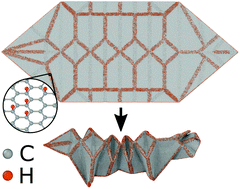Complex three-dimensional graphene structures driven by surface functionalization†
Abstract
The origami technique can provide inspiration for fabrication of novel three-dimensional (3D) structures with unique material properties from two-dimensional sheets. In particular, transformation of graphene sheets into complex 3D graphene structures is promising for functional nano-devices. However, practical realization of such structures is a great challenge. Here, we introduce a self-folding approach inspired by the origami technique to form complex 3D structures from graphene sheets using surface functionalization. A broad set of examples (Miura-ori, water-bomb, helix, flapping bird, dachshund dog, and saddle structure) is achieved via molecular dynamics simulations and density functional theory calculations. To illustrate the potential of the origami approach, we show that the graphene Miura-ori structure combines super-compliance, super-flexibility (both in tension and compression), and negative Poisson's ratio behavior.



 Please wait while we load your content...
Please wait while we load your content...